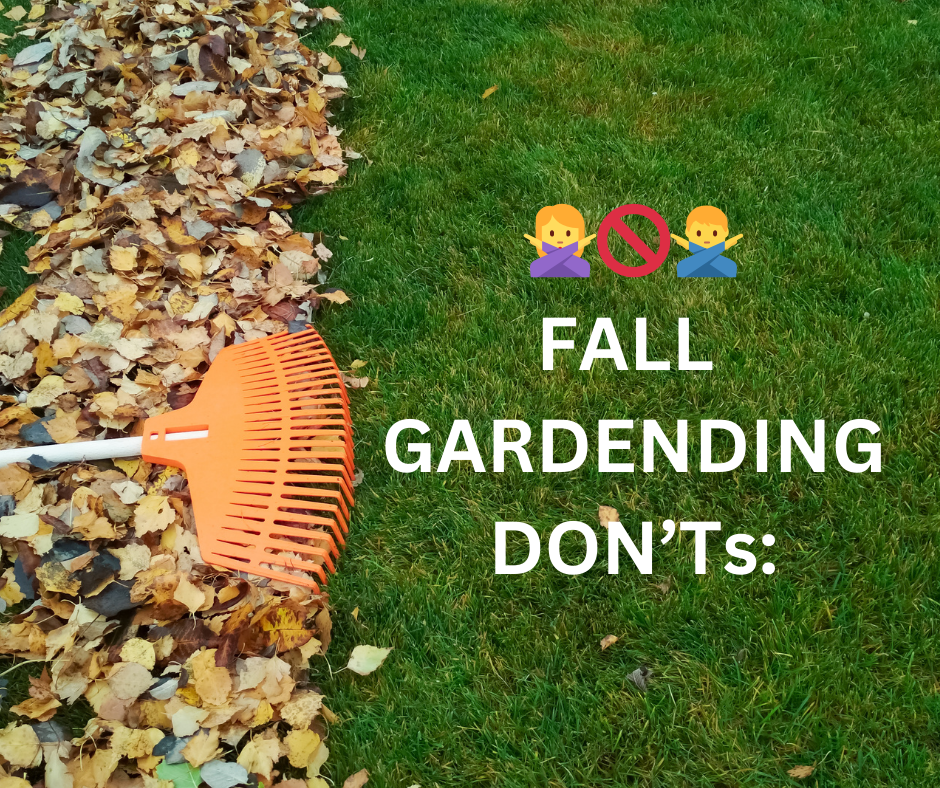Fall Gardening Clean Up Do’s and Don’ts
Fall! It's the bittersweet end of the gardening season. I say bittersweet because it’s sad to see the flowers die and the buzzing bees and butterflies shelter in place or move on, but it’s also a time to plant things that will bring new joy for the next Spring. There are so many wonderful tasks to complete and some that you can skip. I’ll outline this all below, but if you are like me and would rather be out in the garden instead of behind a screen, here is a free, printable download for the do’s and don’t of Fall Garden Cleanup:
Fall Gardening To-Do List:
Plant trees, shrubs, and perennials:
Fall is the best time for planting trees, shrubs, and perennials. When they are dormant above ground, they can focus all of their energy on root establishment. What are the best trees to plant. Check out these suggestions. And here are my favorite low-maintenance perennials.
Stockpile leaves & Mulch garden beds:
Leaves are one of the best soil amendments. Mulch your beds with them or pile them in a cattle panel ring to make leaf mold or add a layer of organic wood mulch to insulate roots and suppress weeds.
Plant spring-blooming bulbs:
Now’s the time to plant daffodils, tulips, and other spring beauties. Purchase high-quality bulb kits here .
Divide perennials:
Divide and replant overcrowded perennials to promote healthy growth next year.
Clean and sharpen tools:
Ensure your tools are ready for next season by cleaning, oiling, and sharpening them.
Test your soil:
Get a soil test to amend your garden with the right nutrients before winter. I provide soil tests and interpret results through Your Garden Pathway Consulting or contact your local extension office.
Leave standing perennials:
Keep plants like ornamental grasses, coneflowers, and bee balm standing to support wildlife.
Fall Gardening Don’t List:
Don’t cut back all perennials only ones showing signs of disease:
Leave beneficial plants like black-eyed susans, globe thistle, and others standing to add winter interest and help wildlife. Here is a blog post listing many more plants to leave until Spring.
Don’t leave diseased foliage:
Remove any dead or diseased plant material to prevent the spread of infections. Remove plants showing signs of powdery mildew or other fungal diseases. Throw the debris out. Do not introduce these pathogens to your compost pile. Peonies are a great example of a plant that you should always cut back in the Fall.
Don’t skip watering evergreens:
Make sure your evergreen perennials are hydrated before the ground freezes.
Don’t forget to prep tender plants:
Bring in or protect tender plants like chrysanthemums or tender bulbs (dahlias) before the first hard frost.
Don’t prune shrubs and trees:
Avoid heavy pruning of shrubs and trees in the fall to prevent winter damage. Plants cannot heal themselves when they are dormant. It is best to stop pruning at least 6-8 weeks before the first frost.
Don’t Neglect Your Soil:
Fall is the perfect time to amend your soil with organic matter or even consider planting a winter cover crop.
As the days grow shorter and the air turns crisp, it's easy to feel a little nostalgic for the bright blooms of summer. But Fall is far from the end—it's the start of a whole new chapter in your garden. By completing a few key tasks now, you're setting the stage for an even more beautiful and thriving garden next spring. So grab your gloves, embrace the season, and get ready to plant, mulch, and divide your way to garden success! And remember, if you're ever unsure or need a little extra help, I'm always here to guide you through the process with Your Garden Pathway Consulting. Happy gardening, and keep blooming! 🌸🍂
Nicole Dillon
Owner of Breemar Flower Farm | Founder of Your Garden Pathway
Ashland, VA | Zone 7b



